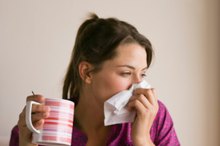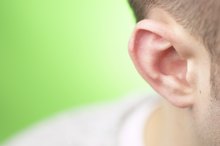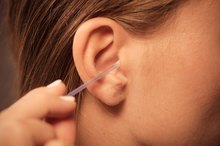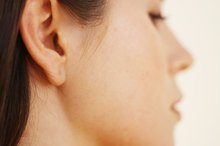Relief From Ear Congestion
Ear congestion, which is a sensation of a full or stuffy ear, can be uncomfortable and annoying -- but is usually not a sign of something serious. This congestion tends to disappear on its own within minutes or days without treatment. In the meantime, the ear discomfort can be managed with home care including over-the-counter medications. If the congestion persists or symptoms are severe, contact a doctor.
If you are experiencing serious medical symptoms, seek emergency treatment immediately.
Causes
Ear congestion is commonly related to extra fluid in the middle ear, and a consequence of allergies or the common cold 5. When the Eustachian tube, which extends from the middle ear to the throat, gets inflamed or blocked with mucus or fluid, the eardrum is unable to move properly and sounds get muffled. The presence of fluid can also cause pressure which creates a popping or crackling sensation in the ear. Vigorous nose blowing can also cause the ears to feel blocked or congested.
- Ear congestion is commonly related to extra fluid in the middle ear, and a consequence of allergies or the common cold 5.
- When the Eustachian tube, which extends from the middle ear to the throat, gets inflamed or blocked with mucus or fluid, the eardrum is unable to move properly and sounds get muffled.
Ear Exercises
How to Unplug Your Ears When You're Sick
Learn More
Plugged or congested ears may be improved by certain exercises that help open up the Eustachian tubes. Swallowing, yawning or chewing gum are common strategies than help. Eating or drinking may also relieve this pressure. The sensation of ear fullness may also be reversed by taking a deep breath, pinching the nostrils closed, then trying to blow air while keeping the mouth closed. If successful, a mild popping sensation and instant relief of congestion can occur.
- Plugged or congested ears may be improved by certain exercises that help open up the Eustachian tubes.
Home Care for Allergies or Colds
Most often, antihistamines and steroid nasal sprays are advised for allergy relief. If the ear discomfort is a symptom of a cold, home measures such as drinking plenty of fluids, using a humidifier or taking a steamy shower or bath may help ease symptoms 5. Using a decongestant nasal spray may also help reduce swelling and decrease Eustachian tube inflammation.
When to See Your Doctor
How to Relieve Pressure in the Ears From Sinus Drainage
Learn More
If home measures don't help relieve symptoms, or if there is significant or persistent ear pain, ear swelling or fever, see a doctor. Also see a doctor if symptoms do not go away within 48 hours or if you suspect there may be a foreign body in the ear. If the ear congestion occurs in a child, speak to a pediatrician before using any over-the-counter medications.
Reviewed by Kay Peck, MPH RD
- If home measures don't help relieve symptoms, or if there is significant or persistent ear pain, ear swelling or fever, see a doctor.
Related Articles
References
- American Academy of Family Physicians: Eustachian Tube Dysfunction
- American Family Physician: Ear Pain: Diagnosing Common and Uncommon Causes
- Merck Manual: Barotrauma of the Ear
- Merck Manual: Common Cold
- Szymanski A, Agarwal A. Anatomy, Head and Neck, Ear Eustachian Tube. National Center for Biotechnology Information. Updated December 6, 2018.
- Szymanski A, Agarwal A. Anatomy, Head and Neck, Ear Eustachian Tube. National Center for Biotechnology Information. Updated December 6, 2018.
- Llewellyn A, Norman G, Harden M, et al. Interventions for adult Eustachian tube dysfunction: a systematic review. Health Technol Assess. 2014;18(46):1-180, v-vi. doi:10.3310/hta18460.
- Casale J. Physiology Eustachian Tube Function. National Center for Biotechnology Information. Updated October 27, 2018.
- Smith ME, Takwoingi Y, Deeks J, et al. Eustachian tube dysfunction: A diagnostic accuracy study and proposed diagnostic pathway. PLoS ONE. 2018;13(11):e0206946. doi:10.1371/journal.pone.0206946.
- Merck Manual Consumer Version. Overview of Middle Ear Infections in Young Children. Updated February 2019.
- Genetic and Rare Disease Information Center. Patulous Eustachian Tube. Updated May 21, 2016.
Writer Bio
Kimberly Rienecke started her career as a health and fitness writer by working for various websites. She is a certified orthopedic physician assistant and an ACE-certified personal trainer. She also holds a Bachelor of Science in biology from Towson University.








